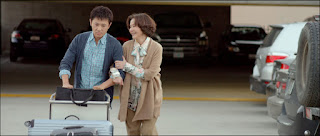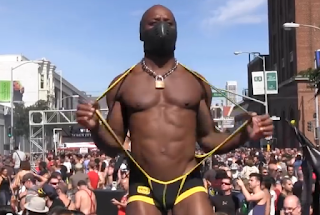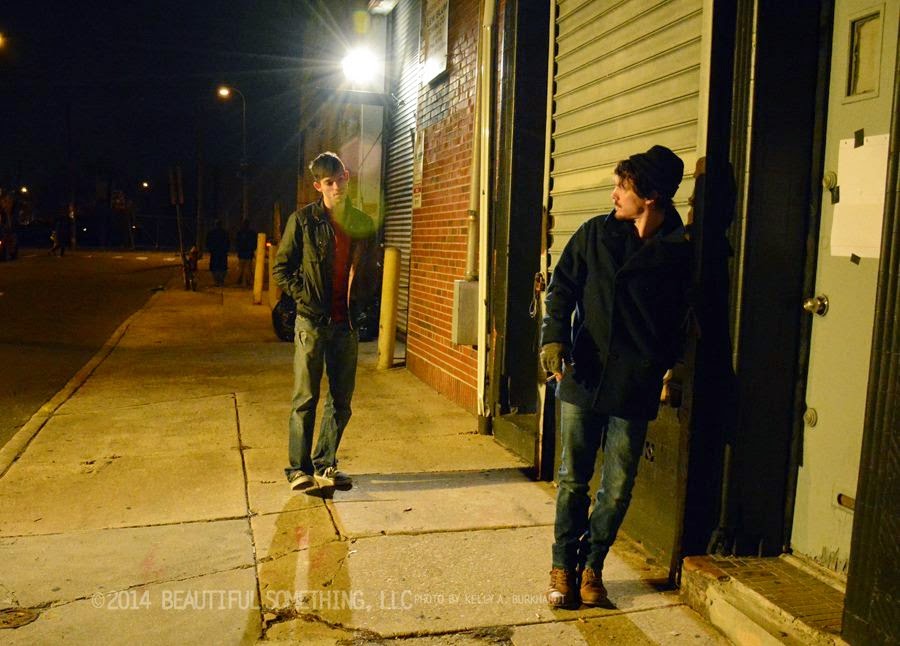Director Michael J. Saul Talks About His Stunning First Feature and Frameline
In Michael J. Saul’s “The Surface” an aimless young man happens upon a yard sale, where he’s drawn to a vintage 8mm camera. His impromptu purchase awakens unexpected impulses, both artistic and personal, which adjust his life’s course and set him on unfamiliar paths toward illuminating destinations. Evan—played with great delicacy by lithe newcomer Harry Hains—is a waiflike, orphaned 22-year-old who grew up in the foster care system and is still feeling unmoored as he enters adulthood in Los Angeles. He is uninspired by his college classes, growing frustrated with his increasingly critical boyfriend, and eager to find something meaningful and fulfilling to connect to in his life. The 8mm camera quickly becomes the creative outlet he’d sought, and he dives headlong into his new hobby. Evan returns to the home of the elderly man who sold him the camera, in search of additional filmmaking equipment, and he ends up leaving with a stash of the family’s old home movies. The quietly poignant films feed Evan’s creativity, providing a (projected) family he never had and sparking not only an intimacy with the family’s past but also a surprising connection to its present.

“The Surface” will be shown at the Castro Theatre Sunday, June 27 at 6 p.m. as part of Frameline39: The San Francisco International LGBTQ Film Festival (which started off back in 1977 with one evening of short Super8 films projected on a bedsheet). Director Michael J. Saul, Actors Harry Hains, Kyle Patrick Darling, Michael Redford, Producer Heath Daniels are expected to attend. Frameline runs from June 18-28 at five different Bay Area venues including the landmark Castro Theatre.
We chatted with Michael about “The Surface,” his film career, and other topics.
Congratulations on “The Surface” which is an incredible film for a first feature length film. How did the story come to you?
Thank you! The main theme of the story was created out of the loss of my parents about six years ago. My father and grandfather had been avid home movie enthusiasts and through my family’s love of these films, they survived very well. So, after my parents passed, I started looking through them and watching myself grow-up in 8mm films. When I mentioned to friends that I had these films, many were jealous and wondered what it was like to have my childhood chronicled in that way. That lead to the idea that a character that had no past, no family ties might meet someone who did possess these treasures and become entwined with him because of his history – almost acquiring someone else’s history for his own. The idea that Evan might be a foster child with no parents or connection to his own past would become the central theme of the story.
Talk about your process as a screenwriter. How quickly are you able to get your ideas expressed on the page? What is your approach to re-writes?
I don’t consider writing my first love or finest creative ability, especially when it comes to dialogue. I tend to write dialogue through my own voice, which doesn’t always translate well to other characters, especially younger ones. I always encourage my cast to improvise dialogue whenever they feel necessary to ring true to the character – and they almost always create better dialogue than I did! However, I think I write fairly good descriptive text on the scene and the feelings of the characters. I tend to break all the rules of screenwriting because; ultimately I am the only one to judge the script.
“The Surface” was roughed out in about a month, with two more versions after that before putting the finishing touches on a shooting script. Once we began filming, the script changed on a daily basis as new ideas, variations on scenes or happy accidents presented themselves that ended up in the final film.
As both writer and director of “The Surface” do you see complete images as you’re writing and how do those images change once you’re on the set?
I do. I’m primarily a visual artist and am ‘optically addicted’. I tend to collect images from books, blogs, websites and anywhere else I can to help convey the movie to others. Even the cast gets a copy of the script accompanied by images, music and videos that help tell the story. So writing then becomes using my imagination, images and videos I’ve seen to help put the film on the page as best I can. There are also lots of times on the set or when you see a new location that ideas change and become these wonderful little moments in the film that you could never have planned.
How many folks do you show your screenplay to during the writing and re-writing process and how open are you to both criticism and suggestions?
Typically I have about three people who read the script. One is my producing partner Heath Daniels who has a great bullshit meter; one is a good friend who is an accomplished writer, and another good friend who knows me very well. These are all people who I trust to tell me when I’m on the right track and sometimes point out issues I never thought of. They also know my body of work and my approach to filmmaking – so they tend to offer up criticism that is helpful to me rather than expressing their own taste. But ultimately, staying true to my vision and my personal story-telling style is most important to me.
The main characters are enriched by compelling backstories and many interesting layers that are revealed as the story progresses. Would you consider this a character-driven film and is that how you prefer to tell your stories?
Definitely. I love all kinds of movies but the ones that stay with me, the ones I think about for days, months or years are the ones about people. I find characters to be fascinating and they absolutely drive my films. Stories are the same but the characters within the story are what can surprise and change us. I credit the cast with creating much of the character backstories that you see. We worked together for months before filming just talking about these people, aspects of their lives that might not even show up on the screen. They all really took this task very seriously and made it a joy for me to watch as their characters unfolded.
Your lead actors are very talented and bring astounding depth to the film. Talk about how you managed to find and cast such wonderful actors.
I knew early on this film would be a challenge to cast. My producing partner Heath Daniels and I had worked together on other film projects such as “Go Go Reject” and “Adults Only”. I admired Heath for his ability to find extraordinary actors not only for the principles, but to inhabit every nook and corner of the frame. So in addition to his duties as co-producer, I asked him to cast the film. We had worked with Michael Redford on “Adults Only” and though he had a small part in that film, we knew we wanted to work with him again. He came in and nailed the part immediately. Nicholas McDonald originally read for Fish, the character now played by Kyle Patrick Darling, but we saw an amazing representation of Chris in him that we just fell in love with, kind of the Andrew McCarthy character from “Pretty in Pink”. We then saw a number of very talented actors for Evan but had a lot of difficulty finding the right one. When Harry Hains came in I was a bit worried that he might be too soft for the role, but during rehearsals he really came through, creating this wonderful, faceted character.
Chemistry is always of great concern when a relationship is explored on film and “The Surface” serves up two very different, realistic pairings. What’s your secret as director for recognizing that certain special spark between actors?
It absolutely begins with casting. You can see very quickly if people like each other and can act together. When this cast came together for the first time, it was clear they were going to create something wonderful together, and that’s just how it happened. If the casting is good then my job as the director is to get out of the way most of the time. I think these things work best when they’re organic. For the three leads it’s also important to let them get to know each other outside of the production, especially if they have intimate scenes. We always encourage them to go to dinner or have a ‘date’ if you will, just to connect on a different level and find some common threads in their own lives. It’s extremely helpful.
Your film maintains an even steady somber tone, which perfectly reflects its theme. Is this something you are aware of during the entire process of bringing “The Surface” to the screen.
I fight with it. People who see the early cuts will always pressure me to lighten it, add something more fun or a way to escape from the mood of the piece, but I have a hard time with that. If it helps the story, if it seems necessary then I add it in, otherwise I feel the mood tells a lot of the story. The scenes with Chris’s friends, the party scenes – those all help to reach outside of Evan’s point of view and breathe a little air into the film, otherwise it really is the world through Evan’s eyes. I wanted there to be an innocence to his view that sets the mood and maintains the vision of the story.
How did you go about getting the production funded? Did you have a budget in mind which you were you able to maintain or were you forced to scale back your vision?
We did a fairly unsuccessful crowd funding campaign and the rest came directly from me unfortunately. However, when starting a film project I firmly believe that once the train starts out of the station, people jump on – and that’s what happened. We found many ‘angels’ who supplied locations, goods and services, cooked for us… that ‘s what making a film is all about for me.
Our friend Stephanie Lehrer for instance allowed us to use her home as the location for Peter’s house, helped us fill in cast and crew whenever we had the need, and generally became our production ‘mom’, that’s why I made her Associate Producer!
I always have to scale back my production a little but luckily for “The Surface”, that was very little.
Tell us about the talented crew that helped you bring your film to life. Are they a combination of seasoned professionals, longtime colleagues, and bright young things?
All of the above. Heath Daniels as I’ve mentioned is always fantastic on the set, he is the Yin to my Yang and sees things I don’t. He doubled as casting director but also dressed everyone. I had a small camera crew including Lauren Peele and Megan McCarthy, location sound by Roana Wullinger, wonderful make-up artists Ricky Flores, Naomi Lark and Lindsay Skinner and set decorators Brandy Maasch and Gina Nasser. It was quite an eclectic group of seasoned pros and young filmmakers and everyone got on wonderfully.
Will this be your first time presenting a film at Frameline? It will be you first feature, so tell us what that means to you as an out filmmaker?
“Go Go Reject” was our first film at Frameline in 2010 and it was such a magical, wonderful experience I always hoped to be invited back. It’s such a supportive community up there and we can’t wait for our premiere.
I’ve been making films and screening in festivals for about 30 years. My films have always had a gay viewpoint in one-way or another. To me, being an out filmmaker is really just so natural. I’ve never shied away from incorporating my sexuality into my work and I’ve always been accepted as a gay filmmaker. I’ve always felt that weaving our stories into the fabric of all film history was more important than being separated by our sexuality. I’d like to see a time when our films become more accepted in the mainstream and not just thought of as “gay film”.
What manners of distribution are you considering for “The Surface?”
Right now we’re just beginning to field offers and interests in distribution, and we are open to all mediums old and new.
You’ve directed many short films. Talk about some of your absolute favorites.
I have a deep emotion for my early works with composer Steven M. Miller, who just passed away last year. They’re short and technically gritty, but very meaningful to me. Of our recent work though, I love “Go Go Reject” because it was the first time anyone asked me to direct a comedy – and it was a great ride. It’s such a fun film. “Adults Only” is one of the most difficult films I’ve ever worked on. It was more intense than most feature films, but the final product is one of great beauty and I’m very proud of it.
You have a real talent for creating engaging short films, which is not an easy task. Talk about what elements need to come together to make a short film resonate with an audience.
Once again I think compelling characters and an interesting idea that we haven’t seen before. If you can engage an audience by showing them something that surprises them or makes them emotional in some way, you’ve found a good story for a short film. After that, you have to be, or hire a great editor. All films are about editing but shorts, by their very nature are about editing the idea down to its simplest terms.
Do you feel cutting your filmmaker’s teeth creating short films was the best route for you?
I love short-form filmmaking and always have. My previous features “True Love” and “Crush” were both made up of short stories. I found it an easy way to continue my love of short-form story telling while exposing my work to a larger audience. I think we all start out making short films because we can’t afford anything else, but making a good short will teach you almost everything you need to know about filmmaking. It’s a great way to get started.
What advice would you offer filmmakers out there who are plugging away to make their film, tell their story?
You have to make it. Just make it. If you have a great story to tell you won’t be happy until you get it on the screen. I know people who have been developing the same script for 15 years. It may actually be made some day, but I’m just too impatient, myself. Every couple of years I have to make a film or go crazy. As I said before, if you start it, people will come to you. People and opportunities and ideas and equipment and things you never thought were right in front of you. So, just make your film.
What’s next up for you?
I have a stack of scripts I’ve written over the years and I’m slowly picking away at them. After “The Surface” is out in the world, I’ll decide what the next project will be. I never really know until it hits me one day.
Michael, congratulations once again and I wish you the very best for ”The Surface” and look forward to your next film.
Thank you so much!






























